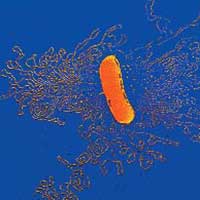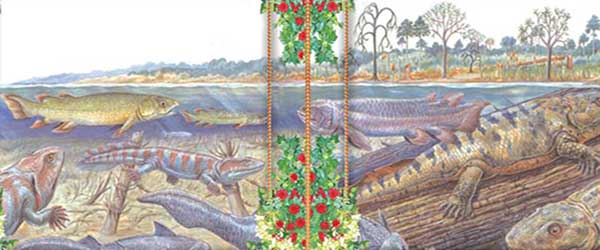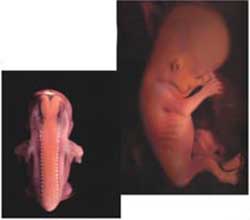Bigotry: The Dark Danger
A Definitive Reply to Evolutionist Propaganda

DOWNLOAD THE BOOK
CHAPTERS OF THE BOOK
- Introduction
- A Series of Blunders Regarding Monkey Intelligence
- The Smuggling Incident National Geographic TV Declined To Cover
- National Geographic TV's Undersea Fairy Tales
- Tall Tales From The National Geographic Channel
- Tales of Transformation from National Geographic Television
- The “Mitochondrial Eve” Deception On The Discovery Channel
- The Dino-Bird Fantasy On The Discovery Channel
- Errors Concerning Human Intelligence From The Discovery Channel
- The Discovery Channel's Spider Dilemma
- Evolutionst Propaganda on The History Channel
- The History Channel's Darwinist and Atheist Propaganda
- New Scientist’s Latest Myth:"Hiccups are a Legacy from Evolution"
- New Scientist’s “ Evolution with Climate” Error
- Paul Davies' Desperate Case for a “Multiverse”
- Evolutionary Tall Tales From The BBC -I-
- Evolutionary Tall Tales From The BBC –II-
- Evolutionary Tall Tales From The BBC –III-
- The BBC's Functionless Tissue Error In Its Documentary The Human Body
- BBC's Evolution of The Human Brain Error
- The Evolutionist Deceptions in the Documentary the Shape of Life
- Evolutionist Deceptions Continue with the Arthropods in the Shape of Life Documentary
- The Evolutionists are Still Struggling with the Same Dilemma: The Origin of Flight
- New Fossil Fish Discoveries Pose a New Dilemma for the Theory of Evolution
- The Latest Version of Baseless Evolutionist Scenarios in Scientific American: Nutrition
- Time Writer M. Lemonick's Mind-Body Error
< <
16 / total: 26
Evolutionary Tall Tales From The BBC -I-
The documentary The Human Body, prepared by the BBC is full of intense propaganda intended to impose the theory of evolution on viewers. Yet this propaganda served no other purpose than to prove that the theory of evolution is nothing but an unscientific myth. The documentary introduces the human body, and describes the so-called evolution of man in a fairy tale manner, offering the viewer no evidence whatsoever. Intended as thoroughgoing propaganda, the documentary actually demonstrates how devoid of scientific support the theory of evolution really is. What follows is a scientific reply to the errors in the documentary: BBC's Bacteria MythBBC's evolutionary tall tales begin with the sentence that there were first of all bacteria in the primitive world, and plants and animals later evolved from these bacteria. The fact is, of course, that the expression "there were bacteria in the primitive world" is meaningless because the problem is how those bacteria came into being. Those who prepared this documentary on BBC might have thought they could gloss over this crucial question on the assumption that their viewers would adopt a superficial view of the matter such as "those bacteria must probably have come into being by themselves." (Even worse, they themselves might hold just such a view.) In truth, however, even the origin of the very simplest bacterium represents a major difficulty for the theory of evolution, one that cannot be glossed over with the words just mentioned.
The origin of bacteria is a problem for the theory of evolution because the theory maintains that life on the primitive earth came about from random chemical reactions. Yet even the simplest bacterium contains such a complex organization and information that these can never be accounted for by any chemical reaction. Let us examine this information: A bacterium has around 2,000 genes, each gene consisting of up to 1,000 letters (codes). This means that the information in its DNA must be at least 2-million letters long. That, in turn, means that the information contained in the DNA of just one bacterium is equivalent to 20 novels of 100,000 words each.1 That being the case, it is quite impossible for a single bacterium to come about by chance or to evolve as the result of chance effects. Any chance intervention to a structure containing information on such a scale would damage the functioning of the bacterium's entire system. A deficiency in a bacterium's genetic code would mean damage to the working system, and therefore death. Robert Shapiro, a professor of chemistry at New York University, calculated the probability that all 2,000 of the different types of proteins that it takes to make up even a simple bacterium could have come into being completely by chance. According to Shapiro, the probability is one in 1040,000.2 (That number is "1" followed by forty thousand zeros and it has no equivalent in the universe.) Chandra Wickramasinghe, a professor of applied mathematics and astronomy at the University of Cardiff, commented on Shapiro's result:
Sir Fred Hoyle, the British mathematician and astronomer, has this to say about these figures:
It is therefore impossible for even the simplest bacterium to have come about by chance, as evolutionists claim. In fact, the theory of evolution is even unable to account for the emergence of just one of the 2,000 kinds of protein that go to make up a simple bacterium. For that reason, saying "first there were bacteria, and plants and animals later developed from bacteria" is a huge deception, devoid of any scientific foundation. Those who prepared the BBC documentary must in any case be aware of this, since they avoided the subject of how the first bacterium came into being, simply beginning their tale with "bacteria that somehow came into being." Furthermore, evolutionists have not one shred of evidence for their evolutionary fantasy; no intermediate form between bacteria and the first plants and animals exists, and they themselves admit the fact. One such evolutionist is Professor Ali Demirsoy, a prominent Turkish defender of evolution, who confesses:
The Mistaken Idea that Bacteria Evolved as their Environment ChangedIt was suggested in the BBC documentary in question that bacteria were gradually exposed to change, as a result of which more complex life forms emerged. This is nothing but a work of the imagination, without any scientific foundation. Bacteria have very short life spans, and a single scientist can therefore observe many generations of them. Evolutionists have thus subjected bacteria to countless mutations for many years, but no evolution has ever been observed in a single one. Pierre-Paul Grassé, one of France's best-known zoologists, the editor of the 35-volume Traité de Zoologie, and former president of the Académie des Sciences, writes the following about this bacterial immutability which invalidates evolution:
In short, if mutations brought about evolution in bacteria, then examples of this should have been seen in the laboratory. Yet, in fact, quite the reverse is the case. The Mistaken Idea that Small Changes Gradually Led to Evolution
In the documentary, space is devoted to evolutionists' traditional claims, and it is maintained that over billions of years small changes occurring in organisms combined and led to new species. There is no scientific foundation for such a claim. The "one by one, small, imperceptible changes" in question are mutations, since mutations are the only mechanism of change the theory of evolution can offer. Mutations are corruptions and changes in living things' genetic codes brought about by various external factors such as radiation and chemical effects. The genetic code of a healthy living thing possesses a flawless order and sequence. Ninety-nine percent of mutations damage DNA (the other 1 percent having no effect). Mutations tear apart, destroy, or confuse the DNA sequences in which a living thing's genetic code is recorded—that is, they eliminate existing information. Hiroshima, Nagasaki, and Chernobyl are just a few contemporary examples of the damaging effect radiation has on genes. As a result of the genetic mutations caused by these tragedies, countless people and other living things lost their lives, many were crippled, and handicapped individuals were born in subsequent generations. The American geneticist B.G. Ranganathan describes the damage mutations do to living organisms in these terms:
That is why there is no mechanism in nature that might bestow minute, imperceptible beneficial changes on living things. The reason why BBC glosses over this subject with superficial accounts and avoids going into any detail on it stems from the fact that it is only too well aware how that change actually came about.
The Mistaken Idea that Species Evolved from One Another
According to evolutionists, all living things developed from one another. A previously existing species turned into another one over time, and all the species eventually emerged in this manner. According to the theory, this transition occupied a period of hundreds of millions of years, and happened in stages. Yet if these evolutionists' claims were true—if, in other words, fish had evolved into reptiles, reptiles into birds, etc., as BBC claims—then countless "intermediary species" should also have emerged and lived during this transformation period. For instance, some half-fish/half-reptiles should have lived in the past that had acquired reptilian traits in addition to the fish traits they already had. Or there should have existed some reptile-birds with novel bird traits in addition to their pre-existing reptilian traits. If such creatures in a transitional process had existed, they would have been crippled, handicapped, and defective organisms. Evolutionists refer to these imaginary creatures, which they believe to have lived in the past, as "transitional forms." If such animals had really existed, there should have been millions and even billions of them. More importantly, the remains of these strange creatures should be present in the fossil record. The number of these transitional forms should have been even greater than the present animal species and their remains should be found all over the world. This is a fact which Darwin also accepted. Even Darwin himself was aware of the absence of such transitional forms. But he hoped that they would be found in the future. Despite his hopefulness, he realized that the biggest stumbling-block to his theory was the missing transitional forms. Therefore, in his book The Origin of Species he wrote the following in the chapter "Difficulties of the Theory":
Despite evolutionists' best efforts, no transitional forms have yet been uncovered. All scientific findings have shown that, contrary to the beliefs of evolutionists, life appeared on earth all of a sudden and fully-formed. A famous British paleontologist, Derek V. Ager, admits this fact even though he is an evolutionist:
Another evolutionist paleontologist Mark Czarnecki comments as follows:
So, since the fact is that no intermediary forms have ever been found, and that this represents a serious problem for the theory of evolution, how is it that BBC and other like-minded evolutionist media are able to continue propagating the myth that "fish became reptiles and reptiles became birds?" The answer to this question is given in an article in the journal Science:
As revealed in Science, behind BBC's unscientific claim lie such factors as "not being unbiased and imagining." BBC presented evolutionary fantasies to the viewer like a fairy tale, talking about "bacteria turning into human beings," and "reptiles that were birds and fish that walked on land," as if it were talking about "the prince who turned into a frog." Why Does BBC Still Portray Haeckel's Deceptions as if they were Science?
Human and fish embryos are compared in the BBC documentary The Human Body, and the theory of "recapitulation," which ceased to be part of scientific literature years ago, is still portrayed as a scientific fact. The term "recapitulation" is a condensation of the dictum "ontogeny recapitulates phylogeny," put forward by the evolutionary biologist Ernst Haeckel at the end of the nineteenth century. This theory of Haeckel's postulates that living embryos re-experience the evolutionary process that their pseudo-ancestors underwent. He theorized that during its development in its mother's womb, the human embryo first displayed the characteristics of a fish, and then those of a reptile, and finally those of a human. It has since been proven that this theory is completely bogus. It is now known that the "gills" that supposedly appear in the early stages of the human embryo are in fact the initial phases of the middle-ear canal, parathyroid, and thymus. That part of the embryo that was likened to the "egg yolk pouch" turns out to be a pouch that produces blood for the infant. The part that was identified as a "tail" by Haeckel and his followers is in fact the backbone, which resembles a tail only because it takes shape before the legs do. These are universally acknowledged facts in the scientific world, and are accepted even by evolutionists themselves. Two leading neo-Darwinists, George Gaylord Simpson and W. Beck, have admitted: "Haeckel misstated the evolutionary principle involved. It is now firmly established that ontogeny does not repeat phylogeny."12 In an article published in American Scientist, we read:
The following was written in an article in New Scientist, dated October 16, 1999:
Another interesting aspect of "recapitulation" was Ernst Haeckel himself, a faker who falsified his drawings in order to support the theory he advanced. Haeckel's forgeries purported to show that fish and human embryos resembled one another. When he was caught out, the only defense he offered was that other evolutionists had committed similar offences:
In the September 5, 1997, edition of the well-known scientific journal Science, an article was published revealing that Haeckel's embryo drawings were the product of a deception. The article, called "Haeckel's Embryos: Fraud Rediscovered," had this to say:
In short, despite its having emerged as early as 1901 that Haeckel's drawings were counterfeit, defenders of the theory of evolution such as BBC portray this theory as if it were scientific fact and attempt to keep the evolution deception alive. Empty Words and Statements Intended to "Bewitch" the Viewer
"The miracle of evolution;" "evolution accomplished this extraordinary transformation;" "the human body shaped by evolution." Expressions such as these are frequently encountered in evolutionist sources. BBC often uses them, trying to inculcate the idea of "the miracle of evolution" alongside striking and colorful images. When these expressions of BBC's are examined closer, however, it can be seen that they are hollow, devoid of any scientific proof and actually state and explain nothing at all. Using such expressions as these, BBC sets out a string of claims, although as one might expect, it fails to explain how any of these might have come about and which evolutionary mechanisms might have wrought such changes. These are some of the issues which BBC does not or cannot explain and which it glosses over with fancy words:
BBC says, "fish evolved into reptiles." Yet, it says not a word about how a creature which breathed in water by means of gills and had no lungs to allow it to breathe on land or feet to walk with, could have immediately adapted to life on land, nor about which organs evolved by means of which evolutionary mechanism. That is because this is a major dilemma for evolutionists, and one that cannot be accounted for by any so-called evolutionary mechanism. BBC says, "reptiles became birds, and reptile scales turned into bird feathers." Once again, however, it fails to discuss how such an impossible evolution might have come about. That is because evolutionists are perfectly well aware that it is impossible for reptiles to have evolved into birds by means of chance mutations, that reptile scales and bird feathers have entirely different structures, and that it is impossible for one to turn into the other.
BBC speaks of "an area shaped by evolution with unbelievable methods over thousands of years" when discussing the bones of the ear. Yet it never actually says what these methods were. That is because no such method is known to BBC or evolutionists. BBC says, "The other parts of the ear, which provides balance and allows us to walk on two legs, as well as to hear, our hands, arms and our entire body took shape thanks to evolution." Yet it never says a word about how evolution shaped all these complex organs. That is because the theory of evolution cannot explain how organs possessed of irreducible complexity came about. BBC says, "Decisions such as how we live, the shape of our bodies, were made billions of years before the appearance of the first human being." Yet it is unable to explain who decided what human beings' eyes, ears, hearts, and brains, which would emerge only billions of years later, would be like, nor who planned such conscious, intelligent, and organized systems in a world full of inanimate matter. Is BBC able to answer such questions? In other words, which unconscious, unaware, and unintelligent atoms in the primitive world could have planned the flawless design in the human body? As we have seen, BBC's evolutionist propaganda is quite baseless. It puts before its viewers claims with no element of reason, logic, or science, under a scientific mask. BBC must be aware that the theory of evolution cannot actually support such claims, since before describing the myth of evolution it stresses that the story is "hard to believe," and continues: "The miracle that makes our bodies' daily lives possible also conceals another great secret from us. That secret, one which is harder to believe, is the story of how we assumed our present appearance." The Mistaken Idea that Life Began by itself in an Environment of Volcanoes and Sulphurous WatersIn order to see how unreasonable and illogical the theory of evolution is, it will be sufficient to have a look at this claim made in the BBC documentary: The program shows an image of Yellowstone National Park in America, where thermal springs are found, and says, "If you had been here 3 billion years ago, you would have witnessed how the first living things came into being." If witnessing the emergence of living things is such an easy matter, as evolutionists claim, why is it that they do not carry out experiments to try and create the first living things in just such an environment? Furthermore, evolutionists could impose whatever conditions they wished in these experiments, using whatever materials they wished. In fact, the uncontrolled, chance effects in the primitive earth could be done away with, and they could use consciously directed mutations instead of random ones. They could even be allowed to use ready-made amino acids and proteins, and all the different materials necessary for life, from phosphate to carbon. Then, in addition to all of this, if they said, "We need time," they could pass the area of the experiment on to one another as a legacy for millions of years. The world's most prominent evolutionary scientists could contribute to the experiment.
Yet, despite all this flexibility given to them, evolutionists would still never be able to bring about roses, leopards, eagles, pigeons, butterflies, budgerigars, cats, fig trees, mulberry trees, orange trees, tomato plants, lemon trees, melons, violets, sunflowers, film producers, writers, nuclear engineers, brain surgeons, university students, professors of biology who study the cells which make up their own bodies, university rectors, heads of state, artists, and architects. They would not even be able to produce a single cell. Despite being an evolutionist, Professor Hoyle admitted this fact:
ConclusionWith the documentary The Human Body, the BBC has entered upon a programme of evolutionary propaganda from which it can never obtain any results. Telling viewers things like "first there were bacteria, which later evolved and eventually became human beings, and this is a great miracle of evolution," without offering any scientific evidence, as if they were reading a bedtime story, is a fruitless attempt to get people to believe in evolution. Today, not even middle school children take evolution seriously; indeed, they find it rather comic. Our hope is that the BBC will realize that this documentary, which it perhaps decided to air solely because of its striking images, actually contains an account which is far removed from true science, and revise it accordingly.
Footnotes1 - Mahlon B. Hoagland, The Roots of Life, Houghton Mifflin Company, 1978, p.18 2 - Robert Shapiro, Origins: A Sceptics Guide to the Creation of Life on Earth, New York, Summit Books, 1986. p.127 3 - Fred Hoyle, Chandra Wickramasinghe, Evolution from Space, New York, Simon & Schuster, 1984, p. 148 4 - Fred Hoyle, Chandra Wickramasinghe, Evolution from Space, p. 130. 5 - Prof. Dr. Ali Demirsoy, Kalitim ve Evrim (Inheritance and Evolution), Ankara, Meteksan Yayınları, p.79 6 - Pierre-Paul Grassé, Evolution of Living Organisms, Academic Press, New York, 1977, p. 87 7- B. G. Ranganathan, Origins?, Pennsylvania: The Banner Of Truth Trust, 1988 8 - Charles Darwin, The Origin of Species, pp. 172, 280 9 - Derek A. Ager, "The Nature of the Fossil Record," Proceedings of the British Geological Association, Vol. 87, 1976, p. 133 10 - Mark Czarnecki, "The Revival of the Creationist Crusade," MacLean's, 19 January 1981, p. 56 11 - Science, July 17, 1981, p. 289 12 - G. G. Simpson, W. Beck, An Introduction to Biology, New York, Harcourt Brace and World, 1965, p. 241 13 - Keith S. Thompson, "Ontogeny and Phylogeny Recapitulated," American Scientist, volume 76, May / June 1988, p. 273 14 - Ken McNamara, "Embryos and Evolution," New Scientist, 16 October 1999 15 - Francis Hitching, The Neck of the Giraffe: Where Darwin Went Wrong, New York: Ticknor and Fields 1982, p. 204 16 - Sir Fred Hoyle, The Intelligent Universe, New York: Holt, Rinehart and Winston, 1983, pp. 20-21
|
16 / total 26
You can read Harun Yahya's book A Definitive Reply to Evolutionist Propaganda online, share it on social networks such as Facebook and Twitter, download it to your computer, use it in your homework and theses, and publish, copy or reproduce it on your own web sites or blogs without paying any copyright fee, so long as you acknowledge this site as the reference.










